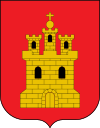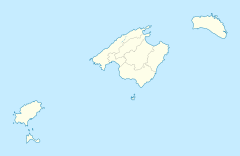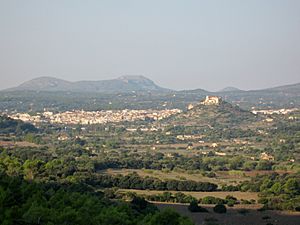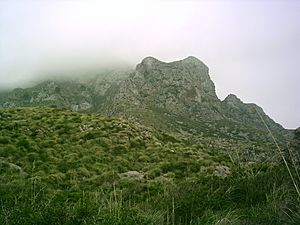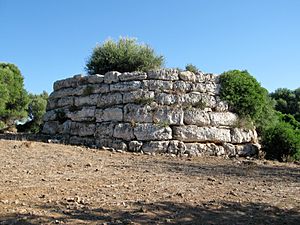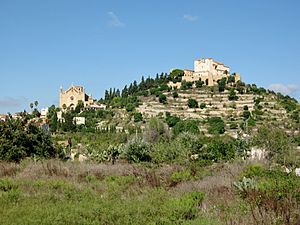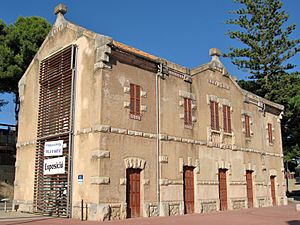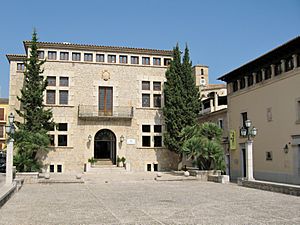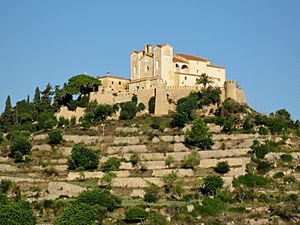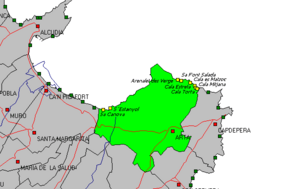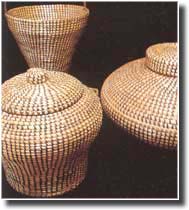Artà facts for kids
Quick facts for kids
Artà
|
||
|---|---|---|
|
Municipality and town
|
||
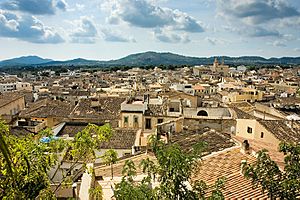 |
||
|
||
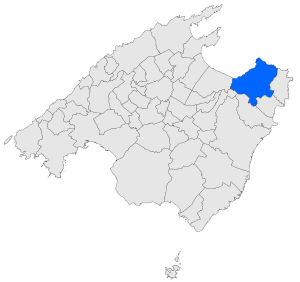
Municipal location
|
||
| Country | ||
| Autonomous Community | Balearic Islands | |
| Province | Balearic Islands | |
| Island | Majorca | |
| Comarca | Llevant | |
| Area | ||
| • Total | 53.97 sq mi (139.79 km2) | |
| Elevation | 505 ft (154 m) | |
| Population
(2018)
|
||
| • Total | 7,671 | |
| Time zone | UTC+1 (CET) | |
| • Summer (DST) | UTC+2 (CEST) | |
| Website | http://www.arta.cat/ | |
Artà is a town and a municipality on the Spanish island of Majorca. It is one of 53 independent towns on the Balearic Islands. The town of Artà is the main center for its area, known as Llevant.
Contents
People Living in Artà
In 2008, about 7,113 people lived in Artà. By 2016, this number grew to 7,448 residents. The official languages spoken here are Catalan and Spanish. People on Majorca often speak a special Catalan dialect called Mallorquí.
Exploring Artà's Geography
Where is Artà Located?
Artà is in the northeast part of Majorca. It is about 60 kilometers (37 miles) from Palma, the island's capital. More than half of the municipality is covered by the Massís d’Artà. This is the highest mountain range in the eastern part of the island.
Artà is on the western side of the peninsula of Artà. To the west, it touches the Bay of Alcúdia. To the north, it meets the Mediterranean Sea. The coast of Artà is 25 kilometers (15.5 miles) long and has not been heavily built up. You can find beautiful beaches and sand dunes like sa Canova d’Artà. There are also rocky coves and many small bays.
Neighboring Towns
To the east and southeast, Artà shares borders with Capdepera and Son Servera. These towns used to be part of Artà until the 19th century. That's why the famous Coves d'Artà (Caves of Artà) are named after Artà, even though they are in Capdepera.
To the southwest, Artà is next to Sant Llorenç des Cardassar and Petra. The Torrent de na Borges river forms Artà's western border with Santa Margalida.
Artà's Villages
The municipality of Artà includes several villages:
- Artà (main town)
- Colònia de Sant Pere
- Urbanització Betlem
- Urbanització Montferrutx
- Urbanització Sant Pere
- Urbanització s’Estanyol
Natural Beauty of Artà
Artà has eight hills, with Puig Morei being the tallest at 561 meters (1,841 feet). Much of the area is wild and untouched, especially in the Serres de Llevant mountains. Sadly, many forest fires have made these areas quite barren.
The rocky coves of Caps de Ferrutx are a safe home for birds like ospreys and peregrine falcons. Wild goats also live along the northern coast. In the valleys, you can find small groups of holly oak trees. Farmers grow almond, fig, and carob trees there.
On the hills, olive trees are common, growing on slopes supported by stone walls. You'll also see fan palms, which are special to this region. These palms are important for local basket makers.
Artà's Climate
Artà gets rain throughout the year. July is the driest month, while October has the most rainfall.
Artà's History
Artà was first mentioned in 1232 as Yartân. Its name comes from the Arabic word "Gertan," meaning "garden."
People have lived in this area for a very long time. Archaeological sites like Ses Païsses and Sa Canova show settlements from 1300–100 BC. You can see ancient coins and tools from the Talaiotic culture at the Artà Regional Museum.
Not much is known about Artà during Roman times. However, the old fortress on the town's hill likely existed before the Arabs came to the island. During the Arab rule (10th to 13th century), this fortress was called Almudaina, meaning "castle."
Today, a thick wall with nine towers surrounds the pilgrimage church of Santuari de Sant Salvador. Inside, there is a beautiful wooden Romanesque statue of the Virgin Mary. People believe James I brought it to the island when he conquered Majorca.
A staircase with 180 steps connects the parish church, Transfiguració del Senyor, to the Sant Salvador church. The Transfiguració church was built in 1573 in a Late Gothic style. It replaced an older church that was built on the site of a former mosque.
During the Arab era, the Yartan peninsula was one of Majorca's thirteen districts. After the Catalans took over, the town of Artà grew in the 13th century. Monks from the Norbertine order founded the Priory of Santa Maria del Bellpuig. The town was called Almudaina in the 15th century, while Artà referred to the whole region.
From the 16th to the 18th century, Artà's population grew a lot. Besides farming, it also developed a textile industry. In 1820, a terrible outbreak of bubonic plague killed 1200 people. Later, in the 19th century, the districts of Capdepera and Son Servera became separate from Artà. Many small farmers started making baskets from palm leaves to earn extra money.
In 1880, the coastal village of Colonia de Sant Pere was founded. It is now a quiet tourist spot and the second largest settlement in the municipality.
In the 20th century, roads connected Artà's villages, helping tourism grow. Even with tourism, large parts of Artà remain natural and unspoiled. This led to the creation of the Parc Natural de la Península de Llevant nature reserve. A railway line to Artà opened in 1921 but no longer runs. However, there are plans to reopen a service from Manacor.
Culture and Fun Places in Artà
Artà is known for its narrow, steep streets that lead up to the medieval fortress walls of the Sant Salvador church. From the top, you get amazing views of the coast, hills, and almond orchards. You can also see the Gothic parish church, Transfiguració del Senyor, below. Inside this church, look for the wooden Majorcan pulpit and the altar.
The Regional Museum of Artà, located at Plaça d'Espanya, opened in 1927. It has different sections:
- Ethnological division: Shows tools used by palm weavers today.
- Archaeological collection: Displays ancient items made of ceramic, bronze, and bone from Majorca's past.
Artà has many interesting places to visit, especially its beautiful coast. The beach of s'Arenal de sa Canova has large sand dunes. A coastal path runs along the beach to the village of s'Estanyol. Further east, you'll find steep cliffs and small sandy beaches.
The northern part of the municipality is dominated by the Massís d’Artà mountains. These include Puig Morei (561m), Puig de sa Tudossa (444m), and Talaia Moreia (432m). In the hills, you can find old towers built between the 16th and 18th centuries. The Ermita de Betlem is a hermitage where monks live, nestled among the hills.
Churches and Monasteries
- Pilgrimage church of Sant Salvador: Surrounded by strong walls.
- Parish church of Transfiguració del Senyor: A beautiful Late Gothic church.
- Franciscan abbey of Sant Antoni de Pàdua: A Baroque church.
- Priory of Santa Maria del Bellpuig: An abbey founded by Norbertine monks.
- Ermita de Betlem hermitage: Located 9 kilometers (5.6 miles) northwest of town in the hills.
Museums and Art
- The regional museum, Museu Regional d’Artà: On Plaça d’Espanya next to the town hall.
- Town hall of Na Batlessa: Has exhibition rooms and a library.
- Teatre d’Artà: A modern theater that opened in 2001.
- Museum House of Can Cardaix
Cool Structures to See
- Steps to the Calvary: Lined with cypress trees and stone crosses.
- Islamic fort of Almudaina d'Artà
- Town square of Plaça del Conqueridor
- Talaiotic village of Ses Païsses: An ancient settlement from prehistoric times.
- Talaiotic settlement on the estate of sa Canova de Morell: Near Colònia de Sant Pere.
Caves to Explore
- Dripstone cave of Coves d'Artà: Located in the municipality of Capdepera on the east coast.
Beaches and Bays
- S’Arenal de Sa Canova
- S’Estanyol
- S’Arenalet des Verger
- Sa Font Celada
- Cala Matzoc
- Cala Estreta
- Cala Mitjana
- Cala Torta
Markets and Fairs
- Street market: Every Tuesday on Plaça del Conqueridor.
- Handicrafts market: Every Tuesday morning at Villa Na Batlessa.
- Artà trade fair: On the second Sunday in September.
Festivals and Celebrations
- Saint Anthony: Celebrated on January 16 and 17.
- Saint Antoni de Pàdua: Also known as the Apricot Festival, on June 13.
- Festival of Sant Salvador: Celebrated on August 5, 6, and 7.
Artà's Economy and Daily Life
Local Handicrafts
In Artà, the craft of basketry (making baskets) is very old and still important. People use the leaves of the native fan palm to create beautiful woven items. These palms grow naturally in Majorca, especially around Artà.
The palm leaves are collected in June and July and then dried in the sun. After drying, they are sorted and sometimes bleached to make them more flexible. These soft leaves, called palmito, are then woven into baskets, hats, backpacks, and bags. Even the leftover parts are used to make brooms and rope. You can find these handmade baskets in many markets on the island.
Famous People from Artà
- Antonio de Literes (1673–1747), a composer.
- Rafel Ginard Bauçà (1899–1976), an author.
- Pere Pujol (1934-2001), a sculptor.
- Xavier Ginard Torres (1986), a professional footballer.
- Abdón Prats (1992), a professional footballer.
- Sergi Darder (1993), a professional footballer.
- Enric Mas (1995), a cyclist.
See also
 In Spanish: Artá para niños
In Spanish: Artá para niños
Images for kids


